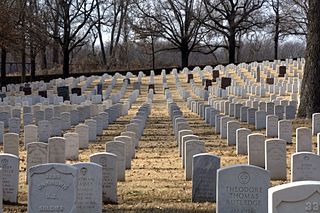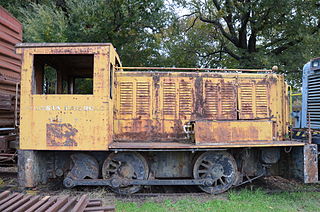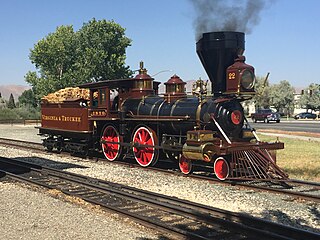
Fort Smith is the third-largest city in Arkansas and one of the two county seats of Sebastian County. As of the 2020 Census, the population was 89,142. It is the principal city of the Fort Smith, Arkansas–Oklahoma Metropolitan Statistical Area, a region of 298,592 residents that encompasses the Arkansas counties of Crawford, Franklin, and Sebastian, and the Oklahoma counties of Le Flore and Sequoyah.

A heritage railway or heritage railroad is a railway operated as living history to re-create or preserve railway scenes of the past. Heritage railways are often old railway lines preserved in a state depicting a period in the history of rail transport.

The St. Louis–San Francisco Railway, commonly known as the "Frisco", was a railroad that operated in the Midwest and South Central United States from 1876 to April 17, 1980. At the end of 1970, it operated 4,547 miles (7,318 km) of road on 6,574 miles (10,580 km) of track, not including subsidiaries Quanah, Acme and Pacific Railway and the Alabama, Tennessee and Northern Railroad; that year, it reported 12,795 million ton-miles of revenue freight and no passengers. It was purchased and absorbed into the Burlington Northern Railroad in 1980. Despite its name, it never came close to San Francisco.

The Fort Zachary Taylor Historic State Park, better known simply as Fort Taylor, is a Florida State Park and National Historic Landmark centered on a Civil War-era fort located near the southern tip of Key West, Florida.

Fort Smith National Historic Site is a National Historic Site located in Fort Smith, Arkansas, along the Arkansas River. The first fort at this site was established by the United States in 1817, before this area was established as part of Indian Territory. It was later replaced and the second fort was operated by the US until 1871. This site was designated as a National Historic Landmark in 1961.

Philander Smith College is a private historically black college, in Little Rock, Arkansas. Philander Smith College is affiliated with the United Methodist Church and is a founding member of the United Negro College Fund (UNCF). Philander Smith College is accredited by the North Central Association of Colleges and Schools.

Fort MacArthur is a former United States Army installation in San Pedro, Los Angeles, California. A small section remains in military use by the United States Air Force as a housing and administrative annex of Los Angeles Air Force Base. The fort is named after Lieutenant General Arthur MacArthur. His son, Douglas MacArthur, would later command American forces in the Pacific during World War II.

Fort Smith National Cemetery is a United States National Cemetery located at Garland Avenue and Sixth Street in Fort Smith, Sebastian County, Arkansas. It encompasses 22.3 acres (9.0 ha), and as of the end of 2005, had 13,127 interments.

The Fort Smith Trolley Museum is a streetcar and railroad museum in Fort Smith, in the U.S. state of Arkansas, which includes an operating heritage streetcar line. The museum opened in 1985, and operation of its streetcar line began in 1991. Four vehicles in its collection, a streetcar and three steam locomotives, are listed on the National Register of Historic Places (NRHP). The now approximately three-quarters-mile-long (1.2 km) streetcar line also passes four NRHP-listed sites, including the Fort Smith National Historic Site, the Fort Smith National Cemetery, the West Garrison Avenue Historic District and the 1907 Atkinson-Williams Warehouse Building, which now houses the Fort Smith Museum of History.

The Arkansas Air National Guard, commonly known as the Arkansas Air Guard, is the aerial militia of the State of Arkansas, United States of America. It is, along with the Arkansas Army National Guard, an element of the Arkansas National Guard. As state militia units, the units in the Arkansas Air National Guard are not typically in the normal United States Air Force chain of command unless federalized. They are under the jurisdiction of the Governor of Arkansas through the office of the Arkansas Adjutant General unless they are federalized by order of the President of the United States. The Arkansas Air National Guard is headquartered at North Little Rock, and its commander is currently Brigadier General Thomas D. Crimmins.

St. Louis–San Francisco 4018 is a class USRA Light 2-8-2 "Mikado" steam locomotive which operated for three decades hauling freight between Bessemer and Birmingham, Alabama, on the St. Louis–San Francisco Railway. It went on display at the Alabama State Fairgrounds in 1952 and is one of only a few locomotives of its type that survive.

Maumelle Ordnance Works Locomotive 1 is a gasoline-powered, mechanically driven, two-axle railway locomotive which was built in 1942 by Vulcan Iron Works for the United States War Department's Maumelle Ordnance Works. It was added to the U.S. National Register of Historic Places in 2006 and is preserved at the Fort Smith Trolley Museum.

St. Louis–San Francisco 4003 is a 2-8-2, Mikado type, standard gauge steam railway locomotive built by the American Locomotive Company in 1919 as a standard USRA Light Mikado for the Pennsylvania Railroad. The PRR, for unknown reasons, rejected 33 of 38 locomotives in the order. The United States Railroad Administration reassigned 23 of them to the St. Louis–San Francisco Railway (SLSF), also known as the "Frisco". The Frisco also received 10 sisters from the Indiana Harbor Belt Railroad, making 33 in all. The locomotive is now on display at the Fort Smith Trolley Museum in Fort Smith, Arkansas.

The Arkansas River Valley is a region in Arkansas defined by the Arkansas River in the western part of the state. Generally defined as the area between the Ozark and Ouachita Mountains, the River Valley is characterized by flat lowlands covered in fertile farmland and lakes periodically interrupted by high peaks. Mount Magazine, Mount Nebo, and Petit Jean Mountain compose the Tri-Peaks Region, a further subdivision of the River Valley popular with hikers and outdoors enthusiasts. In addition to the outdoor recreational activities available to residents and visitors of the region, the River Valley contains Arkansas's wine country as well as hundreds of historical sites throughout the area. It is one of six natural divisions of Arkansas.

Birney Safety Streetcar No. 224 is a streetcar in Fort Smith, Arkansas, listed on the U.S. National Register of Historic Places. Built in 1926 by the American Car Company, it is a type of streetcar known as a Birney "Safety Car". It was listed on the National Register in 1994 and is one of fewer than 10 streetcars listed.

Virginia and Truckee Railroad No. 22, also known as the "Inyo", is a 4-4-0 "American" type steam locomotive that was built by the Baldwin Locomotive Works in 1875 and pulled both passenger and freight trains. The Inyo weighs 68,000 lb (31,000 kg). Its 57 in (140 cm) driving wheels deliver 11,920 lb (5,410 kg) of tractive force. In 1877 it was fitted with air brakes and in 1910 it was converted to burn oil rather than wood.

Fort Collins Municipal Railway Birney Safety Streetcar No. 21 is a streetcar in Fort Collins, Colorado, listed on the U.S. National Register of Historic Places. Built in 1919 by the American Car Company for the Fort Collins Municipal Railway, it is a type of streetcar known as a Birney "Safety Car". It was listed on the National Register in 1984 and is one of fewer than 10 streetcars listed.

The Central Texas Gravel Locomotive No. 210 is a historic diesel-electric switch locomotive at the Arkansas Railroad Museum in Pine Bluff, Arkansas. It was built by General Electric in 1956, and is a well-preserved example of the second generation of GE's 25-ton switching locomotives, a popular model used widely in freight yards throughout the nation and internationally. This model was first used by the Central Texas Gravel Company, and then by the Gifford-Hill Company, which operated it at yards in Shreveport, Louisiana and Eagle Hill, Arkansas. The locomotive was acquired by the museum in 2005, with plans to use it for moving rolling stock within its facilities.

The GE 25-ton switcher is a model of diesel-electric switcher locomotive that was produced by GE Transportation at their Erie, Pennsylvania, facility between 1941 and 1974. Most examples were produced for industrial customers or the United States Armed Forces, although a number of examples were purchased by freight railroads as well. The majority of production was for customers in the United States and Canada, but export models were produced for buyers on five continents. Production totaled approximately 550 units over 33 years, making it one of the most widely produced switchers in American history.





















